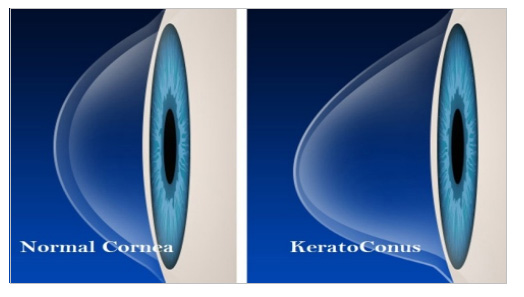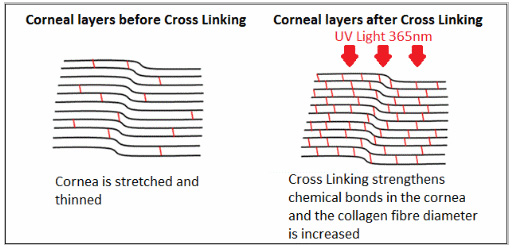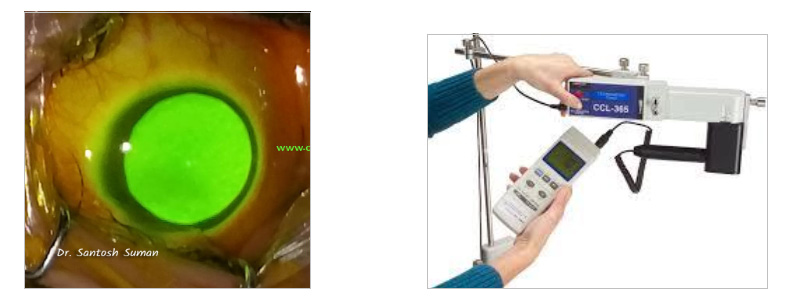1. What is C3R / CXL?
Corneal Collagen Cross Linking using Riboflavin (C3R) is a revolutionary treatment which offers a new hope in patients of progressive Keratoconus.
 Currently, the treatment for Keratoconus includes glasses and / or specially designed rigid gas permeable contact lenses which offer good quality of vision. However, all these treatment options only correct the refractory error in Keratoconus and do not address the issue of progression of the disease. C3R is a new modality of treatment that aims to arrest progression of keratoconus. In advance cases keratoconus can be corrected surgically by corneal transplant.
Currently, the treatment for Keratoconus includes glasses and / or specially designed rigid gas permeable contact lenses which offer good quality of vision. However, all these treatment options only correct the refractory error in Keratoconus and do not address the issue of progression of the disease. C3R is a new modality of treatment that aims to arrest progression of keratoconus. In advance cases keratoconus can be corrected surgically by corneal transplant.
C3R is done to stiffen the cornea. ‘Corneal collagen’ is cross-linked with the help of ultraviolet rays (UV-A) and a photo-sensitizer (Riboflavin), thus enhancing the rigidity of corneal tissue and stabilizing the condition. C3R is not done to remove the glass power. It is done to arrest the progression of keratoconus.

2. What is the main goal of C3R?
The purpose of the treatment is to strengthen the cornea to prevent progressive bulging and thinning that can interfere with vision. With a stronger and more stable cornea the risk of requiring a corneal transplant is minimized or completely eliminated.
3. What is the success rate of C3R ?
The success rate at preventing progressive bulging and thinning has been over 90%. However if allergic eye disease is not controlled and the patient keeps on rubbing the eye, keratoconus can still progress.
4. What is the ideal age of C3R ?
Early C3r has greater chance of preserving vision. With treatment, the corneal contour is preserved, and therefore it is best to have CXL when the shape is only mildly distorted. Patients with advanced keratoconus can have CXL but the vision may be less than ideal with glasses or soft contact lens necessitating the use of a specialised contact lenses.
5. Am I good candidate for C3R ?
For a safe C3R procedure, minimal corneal thickness of 400 microns is required prior to the ultraviolet light application. Corneas with a thickness between 320 microns and less than 400 microns can usually be treated by using specialized hypotonic drops to swell the cornea to 400 microns or greater prior to the ultraviolet light application. Corneas with significant central scarring that interferes with vision are not good candidates for C3R.
6. Will my vision improve after C3R ?
Although the main goal of C3R is to stabilize the cornea, many patients actually have an improvement in their vision. This is due to the fact that the corneal surface becomes less irregular with CXL as the steep areas are flattened and the flat areas are steepened.
7. How is C3R done ?
C3R is usually done under topical anesthesia (after putting anesthetic drops into the eye). The patient is made to lie on the operation table. Eyelid speculum is applied so that patient will not be able to close the eye during surgery. Upper layer of the cornea (epithelium) is usually removed. Riboflavin drops are applied for about half an hour to soak the cornea. You may have little bit of irritation in your eyes during this procedure. After this Ultraviolet-A (UV-A) light is focused over the cornea. You will see a blue-violet color light during UV-A exposure. You have to fix your eye on this light for 10 to 30 minutes (depending upon the type of procedure). At the end of the procedure, a bandage contact lens or a bandage is applied for few hours.

8. What about post-operative care ?
You may have redness, watering and mild pain for 3-4 days, till your corneal epithelium grows back. An antibiotic drop is used for five days to prevent infection. Artificial tears can be used for comfort.
9. What about my vision after C3R ?
Usually the vision is slightly blurry during the first month. Then it gradually improves.
10. How often must the patient come for follow up?
The surgeon will examine the patient’s eye daily for the first 2 to 3 days until the epithelial healing is complete. Eye drops will be used for about 4 months. Patient will have to come for follow up at 6 weeks, 3 months, 6 months, 1 year and 2 years after the procedure. If the patient has associated allergic conjunctivitis, eye drops / ointments can be prescribed for long time.
11. How do I know that the treatment was successful ?
Repeat corneal topography can be performed to know whether keratoconus is still progressing. Topography is typically repeated at 4 to 6 months post-operatively and then annually.
12. Can both eyes be treated at the same time?
Usually one eye is cross-linked at a time. The timing of treatment of the second eye is best decided in consultation with your ophthalmologist.
13. What are the possible side effects of the procedure?
A foreign body sensation, irritation or watering accompanied by pain is common till 3-4 days of treatment. Analgesics for relief from pain will be prescribed and the pain usually subsides within 24 hours. Dryness of the eyes frequently follows this treatment and may last for 6 to 8 months. Tear lubricants are therefore recommended for the period.
14. What are the potential complications of C3R?
C3r is a relatively safe procedure. The risk of infection is rare. In fact ultraviolet light have been used to kill bacteria and parasites in patients with corneal infections. Rarely there is a delay in the healing of the corneal epithelium, which can delay the return of best vision.
15. When can I resume/ start wearing contact lenses after C3R ?
After C3r it is best to wait for about 1 month before returning to contact lens wear.
16.What are the other conditions where C3R is useful?
C3R can also be done for other corneal ectasias like PMCD and Post-LASIK ectasia. Some recent trial is going on for its usefulness in corneal infections.